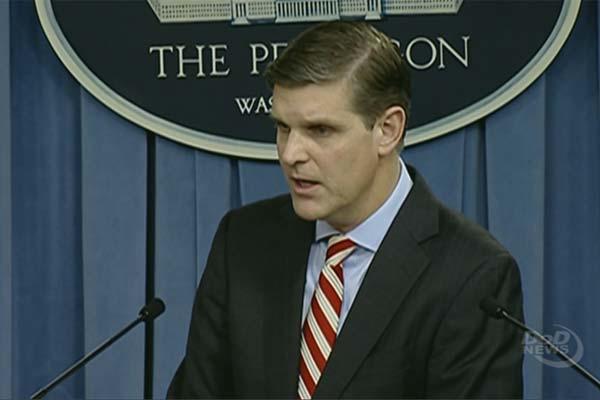The Pentagon pushed back Thursday against Agence France Presse photos appearing to show U.S. Special Forces troops at or near the front lines in Syria with mostly-Kurdish forces moving towards the ISIS stronghold of Raqqa.
"They are not at the front line," but "they have to be in a position to be able to provide the kind of advice needed" to the rebel troops, Pentagon Press Secretary Peter Cook said at a contentious news conference.
Following back and forth on the definition of the Forward Line of Troops, or FLOT, Cook said "I don’t have a yardstick measurement. This is a fluid situation where the forward line of troops can be moving." He did not directly dispute that the well-armed and equipped individuals in the AFP photos were U.S. Special Forces.
White House and the Defense Department officials have repeatedly said that U.S. troops in Iraq and Syria are not in a combat mission and were limited to a train, advise and assist role that would keep them behind the front lines. However, the officials have also said that the troops are at risk and can be involved in combat in self-defense.
The U.S. has acknowledged that three U.S. troops have been killed in combat in Iraq, most recently Navy SEAL Charles Keating IV. He was killed in a firefight north of Mosul in Iraq while serving with a Quick Reaction Force.
The AFP story accompanying the photos said that the troops were identified as Americans by the group they were assisting – the mostly-Kurdish Syrian Democratic Forces (SDF). The SDF, backed by U.S. airstrikes, recently began pushing into villages north of Raqqa, the self-proclaimed capital of the Islamic State of Iraq and Syria.
The AFP report quoted an SDF commander as saying that U.S. troops are "present at all positions along the front. They are taking part on the ground and in the air."
The photos were taken near the town of Fatisah, about 30 miles north of Raqqa. One of the photos showed an individual identified as an American wearing the patch of the Kurdish People’s Protection Unit, or YPG.
The YPG, considered among the most effective of the rebel groups in Syria, has been branded by Turkey as the military wing of the Kurdish Workers Party, or PKK. The PKK is regarded as a terrorist organization by the U.S.
Without confirming or denying that it was an American wearing a YPG patch, Cook said that it was not unusual for Special Forces units to adopt the insignia of partnering groups they advise and assist.
Earlier this week, Army Gen. Joseph Votel, commander of U.S. Central Command, took a group of reporters with him on the first visit by a top commander to the base in northeastern Syria for U.S. Special Forces advisors.
The U.S. sent 50 Special Forces troops into Syria last year and President Obama recently authorized sending 250 more into Syria.
-- Richard Sisk can be reached at richard.sisk@military.com





























